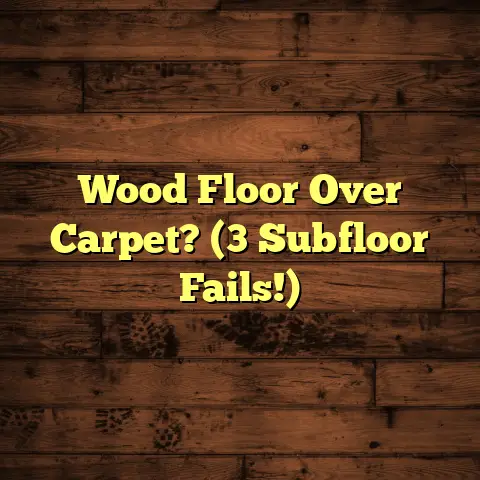Wood Floors & Dogs: Good? Bad? (10 Dog Breeds)
Exploring the Compatibility of Wood Flooring with 10 Popular Dog Breeds
Imagine stepping into a home: Sunlight streams through expansive windows, illuminating the rich grain of gleaming hardwood floors.
A stylish sofa sits atop a plush area rug, and the overall vibe is one of modern elegance and warmth.
This homeowner? They’re on trend. They value aesthetics, durability, and that timeless appeal only wood floors can offer.
But wait! A furry friend bounds into the frame, tail wagging, ready to play.
The question then becomes: Can this picture-perfect scene coexist with the realities of dog ownership?
As a flooring contractor who’s seen it all, I’m here to tell you it can. But it takes knowledge, planning, and a realistic understanding of your dog’s personality and your flooring options.
Let’s dive into the world of wood floors and dogs, exploring the pros, cons, and how to make it work for you and your four-legged companion. We’ll even look at 10 popular breeds and how they typically interact with wood flooring.
Section 1: The Appeal of Wood Floors
Wood floors. They’re a classic for a reason.
But what makes them so desirable? And what options are out there?
First, let’s talk about the types:
-
Oak: The workhorse. It’s durable, readily available, and takes stain beautifully. Think of it as the reliable friend you can always count on.
-
Maple: A lighter, more modern look with a tight grain. It’s a bit harder than oak, but can be tricky to stain evenly.
-
Cherry: Rich, warm tones that deepen over time. It’s softer than oak and maple, so it’s more prone to dents and scratches.
Beyond the aesthetics, wood floors offer some serious benefits:
-
Durability: With proper care, wood floors can last for decades. I’ve seen floors over 100 years old that still look amazing!
-
Ease of Cleaning: Sweep, vacuum, and the occasional damp mop are usually all it takes. Compare that to the effort of cleaning stained carpets!
-
Aesthetic Value: Wood floors add a touch of elegance and sophistication to any home. They’re a timeless investment that can increase your property value.
For homeowners with a taste for contemporary design, wood floors are often a must-have. They provide a neutral backdrop that complements any style, from minimalist to bohemian.
Section 2: The Dog Owner’s Perspective
Okay, let’s be real: Dogs and wood floors aren’t always a match made in heaven.
As a dog owner myself, I understand the concerns:
-
Scratches: Those playful paws can leave their mark, especially on softer wood species.
-
Stains: Accidents happen. And urine can be particularly damaging to wood floors if not cleaned up quickly.
-
Slip Hazards: Smooth wood surfaces can be slippery for dogs, especially older ones or those with joint problems.
Choosing the right flooring for a household with pets is all about balance. You want something that looks great, but can also withstand the wear and tear of daily life with a dog.
It’s about finding that sweet spot between style and practicality.
Section 3: Evaluating Dog Breeds
Not all dogs are created equal when it comes to flooring. A tiny chihuahua is going to have a very different impact than a massive Great Dane.
Let’s break it down by size and energy level, looking at 10 popular breeds:
Subsection A: Large Breeds
Large breeds bring a lot of love (and a lot of potential for damage!). Their size and energy levels can really put wood floors to the test.
-
Labrador Retriever
Labs are known for their playful nature and boundless energy. They love to run, jump, and fetch, which can translate to scratches and dents on your wood floors.
Their nails can also do a number on the finish. Regular nail trims are essential. I recommend every 2-3 weeks for active labs.
According to the American Kennel Club, Labs are consistently ranked as one of the most popular breeds in the US. That means a lot of scratched floors!
-
German Shepherd
German Shepherds are intelligent, active, and protective dogs. They need a lot of exercise, and their size and strength can lead to significant wear and tear on flooring.
They also tend to shed a lot, which can add to the maintenance burden.
I’ve seen German Shepherds literally dig into wood floors when they get excited! Proper training and plenty of outdoor activities are key to minimizing damage.
-
Golden Retriever
Golden Retrievers are similar to Labs in terms of energy level and playfulness. They’re affectionate and eager to please, but their enthusiasm can sometimes get the better of them (and your floors).
They also have a thick coat that sheds regularly, so be prepared for frequent vacuuming.
I always tell clients with Golden Retrievers to invest in high-quality floor mats and area rugs to protect high-traffic areas.
Subsection B: Medium Breeds
Medium-sized dogs can be a bit easier on wood floors than their larger counterparts, but they still require some consideration.
-
Bulldog
Bulldogs are known for their laid-back personality and relatively low energy levels. They’re less likely to cause significant damage to wood floors simply because they’re not as active.
However, their wrinkles and folds require regular cleaning to prevent skin infections, and drool can be an issue. Keep a towel handy!
-
Beagle
Beagles are curious, energetic, and always up for an adventure. Their playful antics can lead to scratches and dents, especially if they’re left unsupervised for long periods.
They also have a strong hunting instinct, which can lead to digging and scratching at floors and furniture. Provide them with plenty of toys and opportunities to explore outdoors.
-
Cocker Spaniel
Cocker Spaniels are affectionate and gentle dogs, but they require regular grooming to prevent matting and tangles. Their long ears are also prone to infections, so regular cleaning is essential.
All that grooming can lead to hair and dander accumulating on your wood floors, so frequent vacuuming is a must.
Subsection C: Small Breeds
Don’t let their size fool you: Small dogs can still cause damage to wood floors! Their nails can be just as sharp as those of larger breeds, and their energy levels can be surprisingly high.
-
French Bulldog
French Bulldogs are adaptable and relatively low-maintenance dogs. Their small size and moderate energy levels make them a good fit for apartment living.
However, they can be prone to breathing problems, so avoid strenuous exercise.
Their weight is also distributed differently than other breeds, so even though they’re small, they can still cause dents and scratches.
-
Dachshund
Dachshunds are known for their long bodies and short legs. They’re energetic and playful, but their unique build can make them prone to back problems.
Their short legs also mean they’re closer to the ground, which can increase their exposure to dirt and debris that can scratch your wood floors.
-
Pug
Pugs are charming and playful dogs, but they can be prone to health problems such as breathing difficulties and eye issues. Their short snouts also make them susceptible to overheating.
They also shed a lot, and their wrinkles require regular cleaning to prevent infections.
I’ve seen Pugs get so excited that they start “scooting” across the floor, which can definitely damage the finish!
-
Shih Tzu
Shih Tzus are affectionate and gentle dogs, but they require regular grooming to prevent matting and tangles. Their long hair can also track dirt and debris onto your wood floors.
They’re also prone to tear staining, which can discolor light-colored carpets and floors.
Regular grooming and cleaning are essential for maintaining both your dog’s health and the appearance of your wood floors.
Section 4: Pros and Cons of Wood Floors with Dogs
Let’s get down to brass tacks. Here’s a breakdown of the advantages and disadvantages of having wood floors in a home with dogs:
| Feature | Pros | Cons |
|---|---|---|
| Appearance | Adds warmth, elegance, and timeless appeal to any home. Complements any décor style. Can increase property value. | Can show scratches and wear over time. May require refinishing to maintain appearance. |
| Durability | With proper care, can last for decades. Can be refinished multiple times. | Susceptible to scratches, dents, and stains from dog nails, accidents, and general wear and tear. Softer wood species are more prone to damage. |
| Maintenance | Easy to clean and maintain with regular sweeping, vacuuming, and damp mopping. | Requires regular cleaning to remove pet hair, dirt, and debris. Accidents need to be cleaned up immediately to prevent staining and damage. May require specialized cleaning products. |
| Hygiene | Naturally hypoallergenic and resistant to dust mites and other allergens. Easier to keep clean and sanitary than carpets. | Can harbor bacteria and odors if not cleaned properly. Urine stains can be difficult to remove completely. |
| Safety | Provides a firm and stable surface for dogs to walk on (when properly sealed and maintained). | Can be slippery for dogs, especially older ones or those with joint problems. Slip hazards can be mitigated with rugs and runners. |
| Cost | Can be a worthwhile investment in the long run due to its durability and aesthetic appeal. | Can be expensive to install and maintain. Refinishing can also be costly. |
So, how do you keep your wood floors looking their best in a dog-friendly home? Here are a few tips:
-
Regular Cleaning: Sweep or vacuum frequently to remove pet hair, dirt, and debris. Use a damp mop with a pH-neutral cleaner to remove spills and stains.
-
Nail Trims: Keep your dog’s nails trimmed to minimize scratches. I recommend using a nail grinder for a smoother, less jarring experience.
-
Protective Coatings: Apply a durable finish to your wood floors to protect them from scratches and stains. Polyurethane is a popular choice for its durability and water resistance.
-
Area Rugs and Mats: Place rugs and mats in high-traffic areas to protect your floors from wear and tear. Choose rugs with non-slip backing to prevent accidents.
-
Accident Cleanup: Clean up accidents immediately to prevent staining and damage. Use an enzymatic cleaner to neutralize odors.
Section 5: Real-Life Experiences
I’ve worked with countless dog owners who have made the switch to wood flooring. Here are a few of their stories:
-
“I was hesitant to get wood floors with my two Labs, but I’m so glad I did! They’re so much easier to clean than carpet, and they look amazing. We just make sure to keep their nails trimmed and clean up any accidents right away.” – Sarah, dog mom to two Labrador Retrievers.
-
“Our German Shepherd used to destroy our carpets, but the wood floors have held up surprisingly well. We invested in a good quality finish and use area rugs in his favorite spots. It’s been a game-changer!” – Mark, proud owner of a German Shepherd.
-
“I have a small Shih Tzu, and I was worried about her tracking dirt and debris onto the wood floors. But with regular grooming and cleaning, it hasn’t been a problem at all. The wood floors are so much more hygienic than carpet.” – Emily, Shih Tzu enthusiast.
Conclusion: The Final Verdict
So, are wood floors and dogs a good mix? The answer, as you might have guessed, is: it depends.
It depends on your dog’s breed, energy level, and grooming needs. It depends on your lifestyle and your willingness to maintain your floors. And it depends on the type of wood flooring you choose and the finish you apply.
But with the right approach, wood floors can coexist beautifully with canine companions. It’s all about making informed decisions, taking preventative measures, and being prepared to clean up after your furry friend.
Don’t let the fear of scratches and stains deter you from creating the home of your dreams.
With a little planning and effort, you can have both beautiful wood floors and a happy, healthy dog.
Call to Action:
What are your experiences with wood floors and dogs? Share your tips, tricks, and stories in the comments below! Let’s create a community where dog lovers can find the best solutions for their flooring needs.





